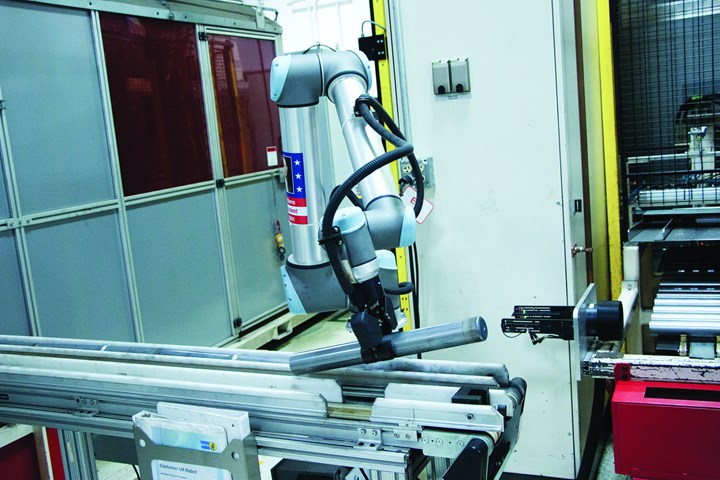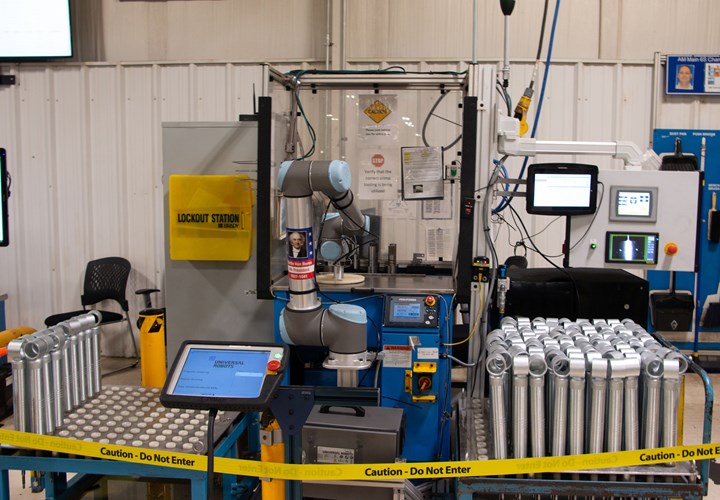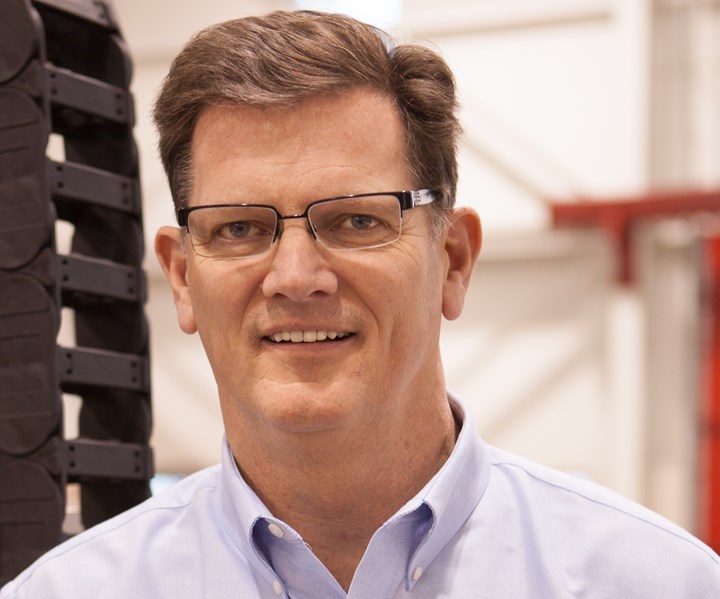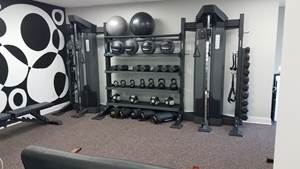Aldo Albieri, operations manager at Thyssenkrupp Bilstein, doesn’t hesitate to call it a “revolution” when he describes the fast rollout of Universal Robots’ collaborative robot arms throughout the company’s Hamilton, Ohio, plant, which manufactures high-tech suspension solutions for the automotive industry. “I felt we were in the right time with the right opportunity to be part of it. We started seeing collaborative robots being used in a completely different way than we traditionally see six-axis robots running,” he says, describing visits to small family-owned machine shops where manufacturers with little or no robotics experience were automating even complex tasks with cobots. “They didn’t use safety caging, and the cobots were placed on wheels and moved between tasks. That was when things really clicked,” says Mr. Albieri, who since this discovery has overseen the implementation of a new cobot at Bilstein’s Hamilton location every other month for almost two years.
“It happened at an incredibly fast pace with us evolving rapidly from trial-and-error in the beginning, using vendors to do the machine integration,” Mr. Albieri says. He soon realized that in-sourcing the cobot deployments was the way to go. His Industry 4.0 team that managed the cobot applications investigated other options, but he says, “We decided to partner with one type of cobot—and that’s when we picked our first cobot with Universal Robots. We realized that UR had the most advanced solution for more precise pick-and-place. The cobot is easy to maintain and program, and it presents the best ratio of speed and repetition.”
Presidential Line-Up
Bilstein’s internal Industry 4.0 group has now deployed nine UR10 cobots, the largest of the UR models, with a 51-inch range and 22-lb payload. A tenth UR10 is used as a test model for future applications. “We are planning to implement about another 40 cobot applications in our organization,” Mr. Albieri says, explaining how the company came up with the naming concept for the new cobot colleagues. “We needed a system that could sequentially be applied to 45 to 50 cobots and decided to have some fun with it by naming them after U.S. presidents.” The cobot fleet now spans from George Washington to John Tyler.
Eliminating Ergonomic Risks
One of the most eye-catching applications at the Hamilton plant features the James Monroe and John Quincy Adams cobots working in tandem assembling Thyssenkrupp’s Active Damping System (ADS) dampers. The multi-step cycle starts with Monroe picking up an innertube that it feeds to a punch machine and then places on a transfer fixture, where Adams picks it up and loads it into a “marriage station,” where it grabs an outer-tube, marries them together, and puts them on the exit chute. While trying to program the cobots to run in sequence with the machines tended, the engineers made a novel discovery to ease the deployment: They realized they could simply teach the cobots to push the start buttons on the machines instead of hardwiring the cobots into the control system.

The John Adams cobot picks and places a part followed by a gage inspection. “Before, we would check two parts every one or two hours to make sure that we were still where we thought we were; but now we have 100-percent inspection,” says Doug McIe, manufacturing engineer at Thyssenkrupp Bilstein.
100% Inspection
Another task now automated is quality inspection, where four cobots do gage inspection and check the post-fill crimp and final parts assembly. “When we did the gage inspection before, we would check two parts every one or two hours to make sure we were still where we thought, but now we have 100% inspection,” says Doug McIe, manufacturing engineer at Thyssenkrupp Bilstein. The cobot deployed in the final assembly is equipped with a Cognex camera and moves swiftly between inspection points to make sure that all components are in the right position and that the label is applied correctly and is readable. “Every single part that comes in is checked, and if it fails, the robot actually rejects it in the process,” Mr. McIe explains.
New Avenue of Growth and ROI
Since Bilstein started to bring the cobot automation in-house, the return on investment (ROI) for the UR cobots has improved. “We have projects with both longer and shorter ROIs,” Mr. Albieri says. “But our comfort zone is a
“No worker will lose his or her job to a robot.”
payback period of about 10 to 14 months to justify the investment. Cobots are definitely a quicker return of investment than traditional robots.” He is now also testing two autonomous mobile robots from Mobile Industrial Robots (MiR) to supply material to the lines, performing the no-value-added handlings between different locations.

Thomas Jefferson (left) and Andrew Jackson cobots work in tandem transitioning newly formed steel tubes from the welding operation to the punching process.
Freeing up labor to work on other tasks plays a significant role in delivering the fast ROI. “The UR cobots gave us the opportunity to grow, expand, create more jobs and move our most valuable resources—our human resources—into new projects, where the know-how was most needed,” Mr. Albieri says, emphasizing that growing the business in today’s labor market without cobots would be difficult. “If we relied only on hiring new people, we would never be able to expand three times the size we originally had. The cobots have opened a new avenue of growth for us while we’ve been able to retain existing workforce. No worker will lose his or her job to a robot.”
Involve the Operators
While Bilstein still deploys traditional automation for fast-paced cycles in enclosed spaces, the company focuses on having the cobots take over tasks where workers define opportunities. Jordan Osterholt, process engineer in the company’s Industry 4.0 group, explains that involving the operators in pinpointing automation-ripe jobs is key. “Operators are at the forefront of all the building that goes on in this company,” he says. “Asking them ‘where can we help you to improve the process?’ has been very useful for us when we develop new applications.”

Located in the Aftermarket section of Bilstein’s Hamilton plant, the eighth UR 10, Martin Van Buren, does the post-fill crimp, picking up from a cart, loading it into the machine and ending the cycle by holding the crimped part up for camera inspection to ensure proper crimping
According to Mr. Albieri, implementation of cobots is not just a technology adventure. “It’s really about implementing a new organization with transparency and open communication,” he says. “You don’t want employees coming into work one day and realizing they have a robot working next to them.” He made sure the first UR cobots were brought in front of the shopfloor team before deployment. “We explained that these cobots were here to expand our business and help remove repetitive ergonomic issues and working conditions that are not the most favorable to people. And that has been the absolutely reality,” he explains, detailing the impact of the cobots’ collaborative nature. “There is not such a big barrier between the people and the technology now. The cobots share the workspace with our employees, who can simply grab the intuitive teach pendant and operate the cobots, as the interface looks more like an iPad than a robot controller.”
The cobots were welcomed by Operator Quenna Quarles, who used to handle the now-automated tasks. “I had a lot of aches and pains in the past, constantly having to physically punch that, move this,” she says. “Now we can flow much better production-wise, and my job is easier as I just load the tubes and let the cobots take care of the rest.”
Copy/Pasting Applications
The engineering team developing the cobot applications did not have any prior robotics experience. “We started by doing simple pick-and-place tasks to get the ball rolling,” Mr. McIe says. “Next was figuring out the interface with the machines. It was a bit harder, but once we got it done, it spread really quickly, and we started seeing applications all over the plant that we could almost copy and paste.”
Mr. Osterholt explains how going through the free UR Academy training modules on the UR website was instrumental in the developing phase. “I would do the tour of how to program the robot and walk straight over to our test robot and apply what I learned,” he says.
Testing New Applications
The demo robot is on wheels so it can simply be rolled up machine-side to test a task. “We can plug the cobot into a regular 110V outlet and start testing right away,” Mr. McIe explains. “With a traditional industrial robot, we would have to first drill holes and bolt it to the floor. This saves us a lot of time.” In addition to deploying a test robot to develop new applications, Bilstein also uses the RoboDK software, certified through the UR+ platform to be plug-and-play with UR cobots. “The software simulations really help us figure out if our cycle time is going to be accurate enough that it’s worth prototyping the tooling and getting it out there. We can put the effort in on the computer screen, and when we deliver it, it’s almost ready to go.”
The Industry 4.0 team is now working on inverting two UR10 cobots on a UR+ certified 7th-axis range extender from Vention and is planning to continue the fast-paced rollout, introducing a new cobot on the shop floor every other month. “There are so many opportunities out there,” Mr. Albieri says. “The sky is the limit.”
Universal Robots USA Inc. | 631-610-9664 | universal-robots.com
Thyssenkrupp Bilstein of America Inc. | 513-881-7600 | bilstein.com
Learn More
Here’s another article on this topic:
Collaborative Robots for DIY Automation
Next-generation, new-generation, co-worker—call it whatever; there is a robotics revolution rolling into manufacturing, warehousing, materials handling and supply chains worldwide.
LINK :: short.gardnerweb.com/urcobot
About the Author
Joe Campbell
Joe Campbell is senior manager of applications development at Universal Robots. The company provides flexible automation solutions that are used throughout the world by manufacturers of all sizes to address labor needs, increase productivity and become more competitive.
Related Content
Manufacturing Skills Training: Virginia Martinez and Laiken Carrillo
Roles of Women in Manufacturing Series: A precision machining career starts with skills. Virginia and Laiken share their journey and how they help prepare the next generation.
Read MoreGift a 3D Printer to an Employee?
Some shops have purchased inexpensive polymer 3D printers for their operations. Does it make sense to take this a step further and give (or loan) a sharp young employee one to experiment with at home? This small investment could pay off for your shop in different ways.
Read MoreApplying a Healthy Approach to Employee Investment
Service Center Metals’ on-site health center offers its employees and their families free same-day health care and, in return, the employer is gaining many benefits including a healthier workforce and attracting potential employees.
Read MoreEmerging Leader's Problem-Solving Skills Cool Down a Hot Project
This 2023 Emerging Leader developed a product in response to a call for help from Yamaha that was a huge hit in the snowmobile industry when it hit the market in 2010. In fact, it is now a common product that most snowmobile OEMs have implemented.
Read MoreRead Next
Working with In-House Integration Systems
When it comes to envisioning, engineering and integrating automation systems for its shop floor, this Ohio shop chooses to tap its internal resources to get the job done. This shop successfully implemented in-house integration to help make it a better business.
Read MoreCollaborative Robots for DIY Automation
Next-generation, new-generation, co-worker — call it whatever; there is a robotics revolution rolling into manufacturing, warehousing, materials handling and supply chains worldwide.
Read More5 Aspects of PMTS I Appreciate
The three-day edition of the 2025 Precision Machining Technology Show kicks off at the start of April. I’ll be there, and here are some reasons why.
Read More























